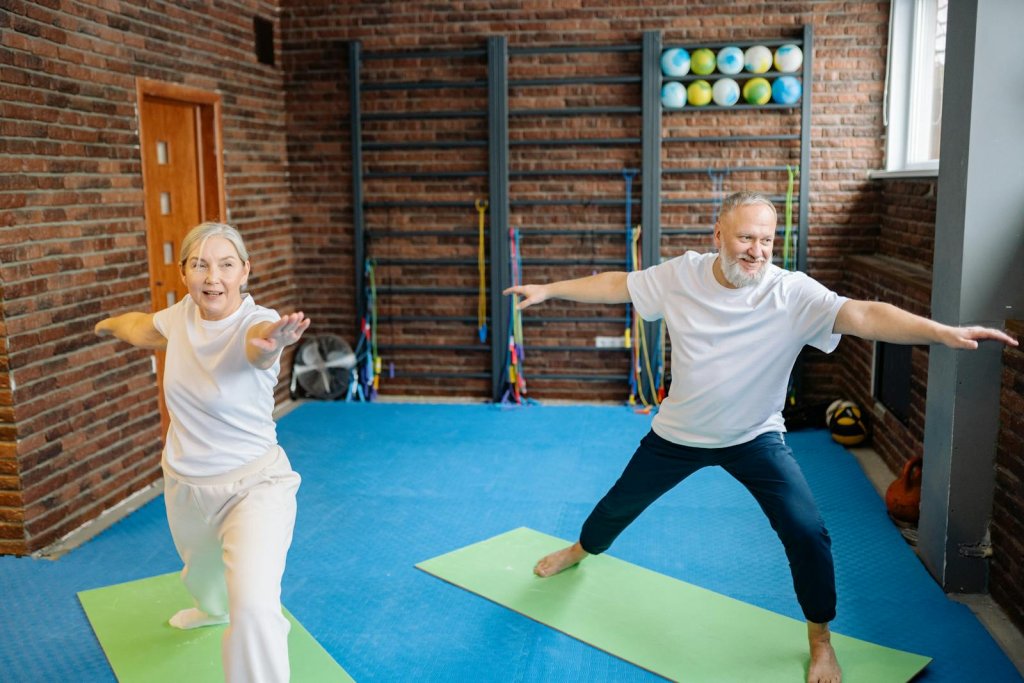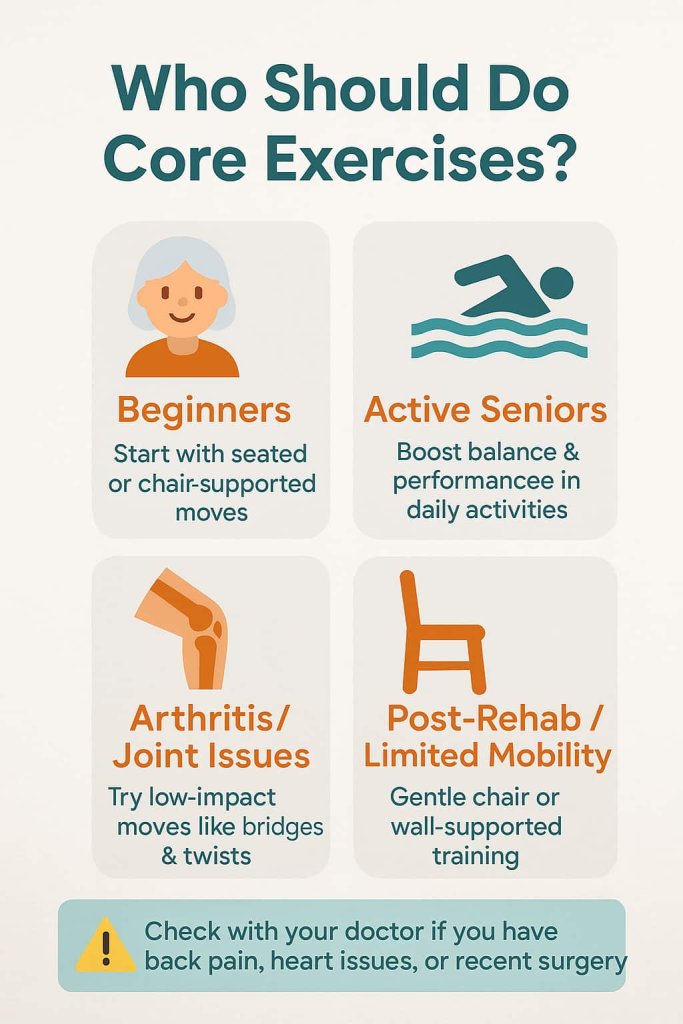Yes, seniors can safely strengthen their core to improve balance, mobility, and stability. Core exercises are one of the best ways to reduce fall risk, stay active, and maintain independence as we age.

A strong core is more than just abs — it supports posture, protects the spine, and improves everyday movements like standing, walking, and bending. For seniors, this means better balance, fewer injuries, and more confidence in daily life.
This guide covers the 10 best core exercises for seniors, with easy step-by-step instructions, safety tips, and benefits. Backed by research from Harvard Health, Cleveland Clinic, and Mayo Clinic, these moves are safe, effective, and beginner-friendly.
Why Core Exercises Matter for Seniors

- Improved Balance & Stability: A strong core helps prevent falls, one of the biggest risks for older adults.
- Posture Support: Reduces slouching and back pain.
- Functional Strength: Makes everyday tasks like standing up, walking, or carrying groceries easier.
- Reduced Injury Risk: Strengthens spine and hips, lowering strain on joints.
- Better Mobility: Supports independence and confidence in movement.
👉 The Centers for Disease Control and Prevention (CDC) reports that over 1 in 4 adults aged 65+ experience a fall each year. Core and balance training are among the best strategies to stay independent and prevent falls.
Who Should Do Core Exercises?
Core exercises are safe and beneficial for almost all seniors, regardless of fitness level. If you can sit, stand, or move with minimal assistance, you can do some form of core training.

- Beginners: Simple seated or chair-supported exercises are a safe starting point.
- Active seniors: Those already walking, swimming, or lifting light weights will see improvements in balance and performance.
- Seniors with arthritis or joint issues: Low-impact moves like bridges, bird dogs, and seated twists reduce strain on knees and back.
- Post-rehab or limited mobility: Modified, gentle movements (with chair or wall support) can help rebuild stability.
👉 Always check with a doctor or physical therapist if you have chronic back pain, heart conditions, or recent surgery before starting a new exercise routine.
10 Best Core Exercises for Seniors
Here are 10 of the best core exercises for seniors, with step-by-step instructions, benefits, and safety tips.
1. Bridge (Glute Bridge)
How to Do It
- Lie on your back with knees bent, feet flat on the floor, hip-width apart.
- Place arms by your sides, palms down.
- Tighten your core and squeeze your glutes.
- Slowly lift hips upward until your body forms a straight line from shoulders to knees.
- Hold 3–5 seconds, then lower gently.
Benefits
- Strengthens glutes, hips, and lower back.
- Improves walking stability and posture.
- Supports spine alignment.
Safety Tip
- Don’t overarch the back.
- Begin with short holds (5–10 seconds) and increase gradually.
2. Bird Dog (Opposite Arm–Leg Raise)
How to Do It
- Start on all fours, wrists under shoulders, knees under hips.
- Extend right arm forward and left leg back.
- Keep hips and shoulders level — no twisting.
- Hold for 3–5 seconds, return, and switch sides.
Benefits
- Builds spinal stability and balance.
- Strengthens abs, lower back, and glutes.
- Improves coordination for daily movements.
Safety Tip
- If balancing both arm and leg is hard, start with just one limb at a time.
- Keep movements slow and controlled.
3. Modified Plank (from Knees)
How to Do It
- Rest forearms on the floor, elbows under shoulders.
- Knees remain on the ground, forming a straight line from head to knees.
- Engage the core and hold for 10–20 seconds.
Benefits
- Builds abdominal endurance without straining the spine.
- Strengthens shoulders and back.
- Prepares body for more advanced core work.
Safety Tip
- Avoid sagging hips or lifting too high.
- Breathe steadily instead of holding your breath.
4. Side Plank (Modified)
How to Do It
- Lie on your side with knees bent.
- Place elbow directly under shoulder.
- Lift hips slightly off the floor, keeping a straight line from head to knees.
- Hold 5–10 seconds per side.
Benefits
- Strengthens obliques (side core muscles).
- Improves lateral (side-to-side) stability.
- Supports spine and posture.
Safety Tip
- Keep bottom knee on the ground for support.
- Avoid letting shoulder sink down.
5. Single-Leg Stand
How to Do It
- Stand tall near a wall or sturdy chair.
- Lift one foot slightly off the ground.
- Hold for 10–30 seconds, then switch sides.
Benefits
- Boosts balance and ankle stability.
- Engages core and leg muscles.
- Reduces fall risk by training coordination.
Safety Tip
- Always practice near support until confident.
- Start with short holds and progress gradually.
6. Heel-to-Toe Walk (Tandem Walk)
How to Do It
- Walk in a straight line, placing heel directly in front of toes with each step.
- Keep arms out to the sides for balance.
- Take 10–20 slow, steady steps.
Benefits
- Enhances balance and coordination.
- Strengthens stabilizing muscles in feet, legs, and core.
- Improves walking confidence.
Safety Tip
- Move slowly.
- Practice near a wall or counter for extra safety.
7. Sit-to-Stand (Chair Exercise)
How to Do It
- Sit in a sturdy chair, feet flat on the ground.
- Lean forward slightly, push through heels, and stand tall.
- Slowly lower back down with control.
- Repeat 8–10 times.
Benefits
- Builds functional strength for daily activities.
- Strengthens core, hips, thighs, and glutes.
- Improves independence (e.g., getting up from chairs, toilets).
Safety Tip
- Avoid using hands if possible, but keep them nearby for support.
- Don’t rush the movement.
8. Marching in Place (High-Knee Marches)
How to Do It
- Stand tall with hands on hips or holding a chair for support.
- Lift one knee toward chest, then lower.
- Alternate legs in a marching motion.
- Perform 30–60 seconds.
Benefits
- Strengthens hip flexors, abs, and balance muscles.
- Improves circulation and mobility.
- Great warm-up or light cardio option.
Safety Tip
- Move at a comfortable pace.
- Hold onto a chair if balance feels unsteady.
9. Standing Core Twist (Wood Chop Motion)
How to Do It
- Hold a light weight (ball, dumbbell, or resistance band).
- Stand tall, feet shoulder-width apart.
- Rotate torso gently side to side, keeping hips forward.
- Perform 10–12 twists each way.
Benefits
- Builds rotational strength for daily tasks (turning, reaching).
- Strengthens obliques and spine stabilizers.
- Improves flexibility in the torso.
Safety Tip
- Use light resistance only.
- Move slowly — avoid sudden, jerky twisting.
10. Tai Chi or Gentle Yoga Poses
How to Do It
- Try beginner-friendly Tai Chi classes or gentle yoga sessions.
- Focus on balance poses like tree pose, seated twists, or supported warrior poses.
- Move slowly with deep breathing.
Benefits
- Improves balance, coordination, and flexibility.
- Builds core strength through controlled movements.
- Enhances relaxation and mental focus.
Safety Tip
- Use a chair or wall for support if needed.
- Start with short, simple routines.
👉 A 2019 Cochrane Review found that exercise programs focusing on balance and functional training — including Tai Chi — significantly reduce fall risk in older adults.
How to Start a Core Exercise Routine Safely
Getting started doesn’t require a gym or special equipment. A few simple steps can make your training effective and risk-free:
- Start Small: Begin with 2–3 exercises, 5–10 minutes per session.
- Warm Up First: March in place, shoulder rolls, or arm swings for 2–3 minutes.
- Focus on Form: Slow, controlled movements matter more than speed or reps.
- Use Support: Perform balance exercises near a chair, wall, or countertop.
- Progress Gradually: Increase hold times or add light resistance only when comfortable.
- Breathe Properly: Exhale during exertion, inhale during release — avoid holding your breath.
- Stay Consistent: Aim for 3–5 days per week for noticeable results.
👉 Pro tip: Keep a short exercise journal to track which moves you’ve done and your progress over time.
Safety & Training Tips for Seniors
- Start slow, with 5–10 minutes daily, then increase.
- Focus on quality over quantity — controlled movements.
- Breathe naturally; avoid holding your breath.
- Use chairs or walls for support when balancing.
- Stop if you feel pain (especially in back, knees, or hips).
- Aim for 3–5 sessions per week for best results.
FAQs About Core Exercises for Seniors
1. How often should seniors do core exercises?
At least 3 times per week, with rest days in between. Even short daily routines (5–10 minutes) are effective.
2. Are crunches safe for seniors?
Traditional crunches can strain the neck and lower back. Safer alternatives include bridges, bird dogs, and seated twists.
3. Can core training really reduce fall risk?
Yes. Core stability directly supports balance and has been linked to reduced fall risk in older adults (Cleveland Clinic, 2024).
4. Do seniors need equipment for core exercises?
Most require no equipment. A chair, mat, or light resistance band is enough.
5. What if I have arthritis or back pain?
Stick to gentle, low-impact moves like bridges, seated marches, and Tai Chi. Always consult your doctor if unsure.
6. Is yoga or Tai Chi better for seniors?
Both are excellent. Tai Chi emphasizes balance and flow, while yoga improves flexibility and posture.
7. Can seniors with limited mobility still train their core?
Yes. Seated core exercises (like seated marches or twists) are safe and effective.
Conclusion
A strong core is the foundation of senior fitness. These 10 best core exercises for seniors are safe, simple, and proven to improve balance, strength, and stability. Whether at home, in the gym, or in a class, regular practice can help you stay active, independent, and confident.
👉 Start with just 2–3 exercises today, build gradually, and enjoy the benefits of a healthier, stronger core.
References
- Mayo Clinic – Balance Exercises for Older Adults
- World Health Organization (WHO) – Guidelines on Physical Activity and Sedentary Behaviour for Adults 65+
